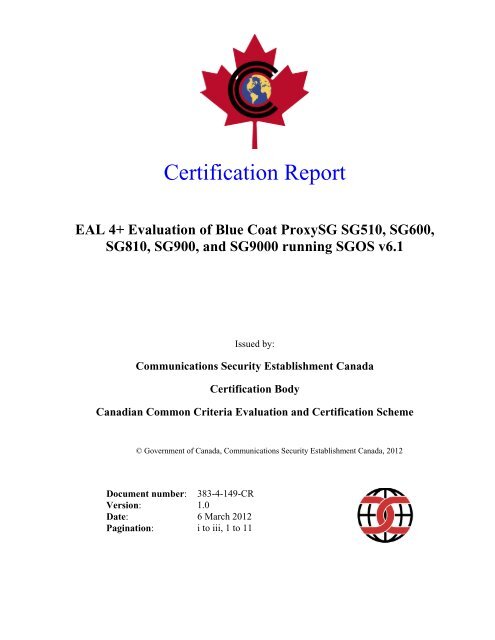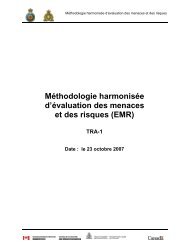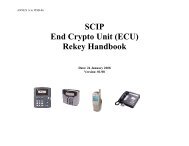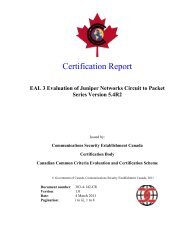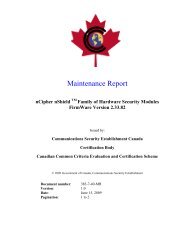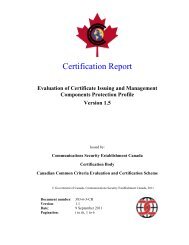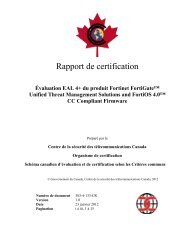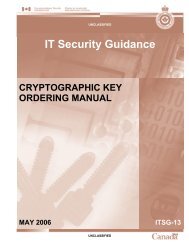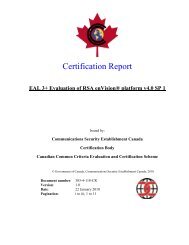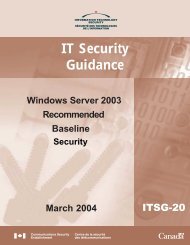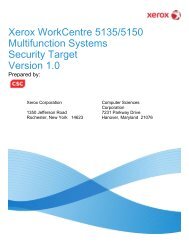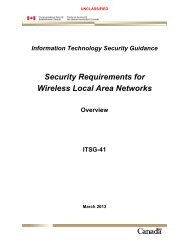EAL 4+ Evaluation of Blue Coat ProxySG SG510, SG600, SG810 ...
EAL 4+ Evaluation of Blue Coat ProxySG SG510, SG600, SG810 ...
EAL 4+ Evaluation of Blue Coat ProxySG SG510, SG600, SG810 ...
Create successful ePaper yourself
Turn your PDF publications into a flip-book with our unique Google optimized e-Paper software.
Certification Report<br />
<strong>EAL</strong> <strong>4+</strong> <strong>Evaluation</strong> <strong>of</strong> <strong>Blue</strong> <strong>Coat</strong> <strong>ProxySG</strong> <strong>SG510</strong>, <strong>SG600</strong>,<br />
<strong>SG810</strong>, SG900, and SG9000 running SGOS v6.1<br />
Issued by:<br />
Communications Security Establishment Canada<br />
Certification Body<br />
Canadian Common Criteria <strong>Evaluation</strong> and Certification Scheme<br />
© Government <strong>of</strong> Canada, Communications Security Establishment Canada, 2012<br />
Document number: 383-4-149-CR<br />
Version: 1.0<br />
Date: 6 March 2012<br />
Pagination: i to iii, 1 to 11
CCS Certification Report<br />
<strong>Blue</strong> <strong>Coat</strong> Systems, Inc.<br />
<strong>ProxySG</strong> 6.1<br />
DISCLAIMER<br />
The Information Technology (IT) product identified in this certification report, and its<br />
associated certificate, has been evaluated at an approved evaluation facility – established<br />
under the Canadian Common Criteria <strong>Evaluation</strong> and Certification Scheme (CCS) – using<br />
the Common Methodology for Information Technology Security <strong>Evaluation</strong>, Version 3.1<br />
Revision 3, for conformance to the Common Criteria for Information Technology Security<br />
<strong>Evaluation</strong>, Version 3.1 Revision 3. This certification report, and its associated certificate,<br />
apply only to the identified version and release <strong>of</strong> the product in its evaluated configuration.<br />
The evaluation has been conducted in accordance with the provisions <strong>of</strong> the CCS, and the<br />
conclusions <strong>of</strong> the evaluation facility in the evaluation report are consistent with the evidence<br />
adduced. This report, and its associated certificate, are not an endorsement <strong>of</strong> the IT product<br />
by the Communications Security Establishment Canada, or any other organization that<br />
recognizes or gives effect to this report, and its associated certificate, and no warranty for the<br />
IT product by the Communications Security Establishment Canada, or any other organization<br />
that recognizes or gives effect to this report, and its associated certificate, is either expressed<br />
or implied.<br />
___________________________________________________________________________<br />
Version 1.0 6 March 2012<br />
- Page i <strong>of</strong> iii -
CCS Certification Report<br />
<strong>Blue</strong> <strong>Coat</strong> Systems, Inc.<br />
<strong>ProxySG</strong> 6.1<br />
FOREWORD<br />
The Canadian Common Criteria <strong>Evaluation</strong> and Certification Scheme (CCS) provides a<br />
third-party evaluation service for determining the trustworthiness <strong>of</strong> Information Technology<br />
(IT) security products. <strong>Evaluation</strong>s are performed by a commercial Common Criteria<br />
<strong>Evaluation</strong> Facility (CCEF) under the oversight <strong>of</strong> the CCS Certification Body, which is<br />
managed by the Communications Security Establishment Canada.<br />
A CCEF is a commercial facility that has been approved by the CCS Certification Body to<br />
perform Common Criteria evaluations; a significant requirement for such approval is<br />
accreditation to the requirements <strong>of</strong> ISO/IEC 17025:2005, the General Requirements for the<br />
Competence <strong>of</strong> Testing and Calibration Laboratories. Accreditation is performed under the<br />
Program for the Accreditation <strong>of</strong> Laboratories - Canada (PALCAN), administered by the<br />
Standards Council <strong>of</strong> Canada.<br />
The CCEF that carried out this evaluation is CGI IT Security <strong>Evaluation</strong> & Test Facility<br />
located in Ottawa, Canada.<br />
By awarding a Common Criteria certificate, the CCS Certification Body asserts that the<br />
product complies with the security requirements specified in the associated security target. A<br />
security target is a requirements specification document that defines the scope <strong>of</strong> the<br />
evaluation activities. The consumer <strong>of</strong> certified IT products should review the security target,<br />
in addition to this certification report, in order to gain an understanding <strong>of</strong> any assumptions<br />
made during the evaluation, the IT product's intended environment, its security requirements,<br />
and the level <strong>of</strong> confidence (i.e., the evaluation assurance level) that the product satisfies the<br />
security requirements.<br />
This certification report is associated with the certificate <strong>of</strong> product evaluation dated 6 March<br />
2012, and the security target identified in Section 4 <strong>of</strong> this report.<br />
The certification report, certificate <strong>of</strong> product evaluation and security target are posted on the<br />
CCS Certified Products list (CPL) and the Common Criteria portal (the <strong>of</strong>ficial website <strong>of</strong><br />
the Common Criteria Project).<br />
This certification report makes reference to the following registered trademarks:<br />
• <strong>Blue</strong> <strong>Coat</strong>, <strong>ProxySG</strong>, SGOS, <strong>Blue</strong> Touch Online and the <strong>Blue</strong> <strong>Coat</strong> logo are registered<br />
trademarks <strong>of</strong> <strong>Blue</strong> <strong>Coat</strong> Systems, Inc. in the United States and other countries.<br />
Reproduction <strong>of</strong> this report is authorized provided the report is reproduced in its entirety.<br />
___________________________________________________________________________<br />
Version 1.0 6 March 2012<br />
- Page ii <strong>of</strong> iii -
CCS Certification Report<br />
<strong>Blue</strong> <strong>Coat</strong> Systems, Inc.<br />
<strong>ProxySG</strong> 6.1<br />
TABLE OF CONTENTS<br />
Disclaimer ....................................................................................................................................... i<br />
Foreword........................................................................................................................................ ii<br />
Executive Summary...................................................................................................................... 1<br />
1 Identification <strong>of</strong> Target <strong>of</strong> <strong>Evaluation</strong> ................................................................................ 2<br />
2 TOE Description ................................................................................................................... 2<br />
3 Evaluated Security Functionality........................................................................................ 2<br />
4 Security Target...................................................................................................................... 3<br />
5 Common Criteria Conformance.......................................................................................... 3<br />
6 Security Policy....................................................................................................................... 3<br />
7 Assumptions and Clarification <strong>of</strong> Scope............................................................................. 4<br />
7.1 SECURE USAGE ASSUMPTIONS................................................................................... 4<br />
7.2 ENVIRONMENTAL ASSUMPTIONS ............................................................................... 4<br />
7.3 CLARIFICATION OF SCOPE.......................................................................................... 5<br />
8 Evaluated Configuration...................................................................................................... 5<br />
9 Documentation ...................................................................................................................... 5<br />
10 <strong>Evaluation</strong> Analysis Activities ............................................................................................. 6<br />
11 ITS Product Testing.............................................................................................................. 8<br />
11.1 ASSESSMENT OF DEVELOPER TESTS .......................................................................... 8<br />
11.2 INDEPENDENT FUNCTIONAL TESTING ........................................................................ 8<br />
11.3 INDEPENDENT PENETRATION TESTING....................................................................... 9<br />
11.4 CONDUCT OF TESTING ............................................................................................... 9<br />
11.5 TESTING RESULTS...................................................................................................... 9<br />
12 Results <strong>of</strong> the <strong>Evaluation</strong>.................................................................................................... 10<br />
13 Evaluator Comments, Observations and Recommendations ......................................... 10<br />
14 Acronyms, Abbreviations and Initializations................................................................... 10<br />
15 References............................................................................................................................ 11<br />
___________________________________________________________________________<br />
Version 1.0 6 March 2012<br />
- Page iii <strong>of</strong> iii -
CCS Certification Report<br />
<strong>Blue</strong> <strong>Coat</strong> Systems, Inc.<br />
<strong>ProxySG</strong> 6.1<br />
Executive Summary<br />
<strong>Blue</strong> <strong>Coat</strong> <strong>ProxySG</strong> <strong>SG510</strong>, <strong>SG600</strong>, <strong>SG810</strong>, SG900, and SG9000 running SGOS v6.1<br />
(hereafter referred to as <strong>ProxySG</strong> 6.1), from <strong>Blue</strong> <strong>Coat</strong> Systems, Inc, is the Target <strong>of</strong><br />
<strong>Evaluation</strong> (TOE) for this <strong>Evaluation</strong> Assurance Level (<strong>EAL</strong>) 4 augmented evaluation.<br />
<strong>ProxySG</strong> 6.1 consists <strong>of</strong> appliances manufactured by <strong>Blue</strong> <strong>Coat</strong> Systems running a<br />
proprietary operating system. <strong>ProxySG</strong> v6.1 provides a layer <strong>of</strong> security between an internal<br />
network and an external network (typically an <strong>of</strong>fice network and the Internet) by enforcing<br />
information flow rules on selected traffic protocols. In addition, the system also provides the<br />
ability to optimize Wide Area Network (WAN) traffic.<br />
<strong>ProxySG</strong> 6.1 is deployed as a purpose-built hardware/s<strong>of</strong>tware appliance installed at each<br />
site and can be configured to provide transparent forward proxy services to all internal users.<br />
CGI IT Security <strong>Evaluation</strong> & Test Facility is the CCEF that conducted the evaluation. This<br />
evaluation was completed on 16 February 2012 and was carried out in accordance with the<br />
rules <strong>of</strong> the Canadian Common Criteria <strong>Evaluation</strong> and Certification Scheme (CCS).<br />
The scope <strong>of</strong> the evaluation is defined by the security target, which identifies assumptions<br />
made during the evaluation, the intended environment for <strong>ProxySG</strong> 6.1, the security<br />
requirements, and the level <strong>of</strong> confidence (evaluation assurance level) at which the product is<br />
intended to satisfy the security requirements. Consumers are advised to verify that their<br />
operating environment is consistent with that specified in the security target, and to give due<br />
consideration to the comments, observations and recommendations in this certification<br />
report.<br />
The results documented in the <strong>Evaluation</strong> Technical Report (ETR) 1 for this product provide<br />
sufficient evidence that it meets the <strong>EAL</strong> 4 augmented assurance requirements for the<br />
evaluated security functionality. The evaluation was conducted using the Common<br />
Methodology for Information Technology Security <strong>Evaluation</strong>, Version 3.1 Revision 3, for<br />
conformance to the Common Criteria for Information Technology Security <strong>Evaluation</strong>,<br />
Version 3.1 Revision 3. The following augmentation is claimed: ALC_FLR.2 – Flaw<br />
Reporting Procedures.<br />
Communications Security Establishment Canada, as the CCS Certification Body, declares<br />
that the <strong>ProxySG</strong> 6.1 evaluation meets all the conditions <strong>of</strong> the Arrangement on the<br />
Recognition <strong>of</strong> Common Criteria Certificates and that the product will be listed on the CCS<br />
Certified Products List (CPL) and the Common Criteria portal (the <strong>of</strong>ficial website <strong>of</strong> the<br />
Common Criteria Project).<br />
1 The ETR is a CCS document that contains information proprietary to the developer and/or the evaluator, and<br />
is not releasable for public review.<br />
___________________________________________________________________________<br />
Version 1.0 6 March 2012<br />
- Page 1 <strong>of</strong> 11 -
CCS Certification Report<br />
<strong>Blue</strong> <strong>Coat</strong> Systems, Inc.<br />
<strong>ProxySG</strong> 6.1<br />
1 Identification <strong>of</strong> Target <strong>of</strong> <strong>Evaluation</strong><br />
The Target <strong>of</strong> <strong>Evaluation</strong> (TOE) for this <strong>Evaluation</strong> Assurance Level (<strong>EAL</strong>) 4 augmented<br />
evaluation is <strong>ProxySG</strong> <strong>SG510</strong>, <strong>SG600</strong>, <strong>SG810</strong>, SG900, and SG9000 running SGOS v6.1<br />
(hereafter referred to as <strong>ProxySG</strong> 6.1), from <strong>Blue</strong> <strong>Coat</strong> Systems, Inc.<br />
2 TOE Description<br />
<strong>ProxySG</strong> 6.1 consists <strong>of</strong> appliances manufactured by <strong>Blue</strong> <strong>Coat</strong> Systems running a<br />
proprietary operating system. <strong>ProxySG</strong> 6.1 provides a layer <strong>of</strong> security between an internal<br />
network and an external network (typically an <strong>of</strong>fice network and the Internet) by enforcing<br />
information flow rules on selected traffic protocols. In addition, <strong>ProxySG</strong> 6.1 provides the<br />
ability to optimize Wide-Area-Network (WAN) traffic.<br />
<strong>ProxySG</strong> 6.1 is deployed as a purpose-built hardware/s<strong>of</strong>tware appliance installed at each<br />
site and can be configured to provide transparent forward proxy services to all internal users.<br />
3 Evaluated Security Functionality<br />
The complete list <strong>of</strong> evaluated security functionality for <strong>ProxySG</strong> 6.1 is identified in Section<br />
6 <strong>of</strong> the ST.<br />
<strong>ProxySG</strong> 6.1 provides encryption and decryption <strong>of</strong> all data transmitted between the TOE<br />
using a FIPS 140-2-validated cryptographic module. The following cryptographic modules<br />
were evaluated to the FIPS 140-2 standard:<br />
Cryptographic Module Certificate #<br />
<strong>ProxySG</strong> 510-5, 510-10, 510-20, 510-25, 810-5, 810-10, Pending 2<br />
810-20, 810-25<br />
<strong>ProxySG</strong> 600-10, 600-20, 600-35<br />
Pending<br />
<strong>ProxySG</strong> 900-10, 900-20, 900-30, 900-45<br />
Pending<br />
<strong>ProxySG</strong> 9000-10, 9000-20<br />
Pending<br />
The following Government <strong>of</strong> Canada approved cryptographic algorithms were evaluated for<br />
correct implementation in <strong>ProxySG</strong> 6.1:<br />
2<br />
The cryptographic module is in the process <strong>of</strong> FIPS 140-2 validation under the Cryptographic Module<br />
Validation Program (CMVP). Information regarding the status <strong>of</strong> the module validation can be found on the<br />
NIST website.<br />
___________________________________________________________________________<br />
Version 1.0 6 March 2012<br />
- Page 2 <strong>of</strong> 11 -
CCS Certification Report<br />
<strong>Blue</strong> <strong>Coat</strong> Systems, Inc.<br />
<strong>ProxySG</strong> 6.1<br />
Cryptographic Algorithm Certificate #<br />
Triple-DES (3DES) 1218<br />
Advanced Encryption Standard (AES) 1875<br />
Secure Hash Standard (SHS) 1648<br />
Deterministic Random Bit Generators (DRBG) - Random 153<br />
Number Generator (RNG) based on NIST SP 800-90<br />
Rivest Shamir Adleman (RSA) 956<br />
Keyed-Hash Message Authentication Code (HMAC) 1120<br />
4 Security Target<br />
The ST associated with this Certification Report is identified by the following nomenclature:<br />
Title: <strong>Blue</strong> <strong>Coat</strong> Systems, Inc. <strong>ProxySG</strong> <strong>SG510</strong>, <strong>SG600</strong>, <strong>SG810</strong>, SG900, and SG9000<br />
running SGOS v6.1 Security Target<br />
Version: v1.3<br />
Date: 15 February 2012<br />
5 Common Criteria Conformance<br />
The evaluation was conducted using the Common Methodology for Information Technology<br />
Security <strong>Evaluation</strong>, Version 3.1 Revision 3, for conformance to the Common Criteria for<br />
Information Technology Security <strong>Evaluation</strong>, Version 3.1 Revision 3.<br />
<strong>ProxySG</strong> 6.1 is:<br />
a. Common Criteria Part 2 extended, with functional requirements based upon functional<br />
components in Part 2, except for the following explicitly stated requirements defined in<br />
the ST:<br />
• FIA_PCR_EXT.1 – Password controlled role; and<br />
• FRU_ARP_EXT.1 – Health check alarms<br />
b. Common Criteria Part 3 conformant, with security assurance requirements based only<br />
upon assurance components in Part 3; and<br />
c. Common Criteria <strong>EAL</strong> 4 augmented, containing all security assurance requirements in<br />
the <strong>EAL</strong> 4 package, as well as the following: ALC_FLR.2 – Flaw Reporting Procedures.<br />
6 Security Policy<br />
<strong>ProxySG</strong> 6.1 implements an Administrative Access Security Functional Policy (SFP) which<br />
ensures administrative interfaces are available only under specific rules using attributes such<br />
as authenticated identity, group membership and time <strong>of</strong> day.<br />
___________________________________________________________________________<br />
Version 1.0 6 March 2012<br />
- Page 3 <strong>of</strong> 11 -
CCS Certification Report<br />
<strong>Blue</strong> <strong>Coat</strong> Systems, Inc.<br />
<strong>ProxySG</strong> 6.1<br />
<strong>ProxySG</strong> 6.1 also implements two information flow control policies, the Proxy SFP and the<br />
WAN Optimization SFP. Both policies enforce rules for the transit traffic, in terms <strong>of</strong> what<br />
traffic can pass through the TOE, and the actions that need to take place on the traffic as it<br />
passes through the TOE.<br />
Details <strong>of</strong> these security policies can be found in Section 1.4.2.3 <strong>of</strong> the ST.<br />
In addition, <strong>ProxySG</strong> 6.1 implements policies pertaining to security audit, cryptographic<br />
support, identification and authentication, security management, protection <strong>of</strong> TOE security<br />
functionality, resource utilization and TOE access. Further details on these security policies<br />
may be found in Section 6 <strong>of</strong> the ST.<br />
7 Assumptions and Clarification <strong>of</strong> Scope<br />
Consumers <strong>of</strong> <strong>ProxySG</strong> 6.1 should consider assumptions about usage, policies in place and<br />
environmental settings as requirements for the product’s installation and its operating<br />
environment. This will ensure the proper and secure operation <strong>of</strong> the TOE.<br />
7.1 Secure Usage Assumptions<br />
The following Secure Usage Assumptions are listed in the ST:<br />
• Administrators are non-hostile and follow all administrator guidance when using the<br />
TOE. Administration is competent and on-going;<br />
• The TOE has been installed and configured according to the appropriate installation<br />
guides; and<br />
• Passwords for administrative access to the TOE and for End User accounts are at<br />
least five characters in length, and are not dictionary words.<br />
7.2 Environmental Assumptions<br />
The following Environmental Assumptions are listed in the ST:<br />
• The TOE is located in an environment that provides physical security, uninterruptible<br />
power, air conditioning, and all other conditions required for reliable operation <strong>of</strong> the<br />
hardware. Physical access to the appliance is restricted to authorized persons; and<br />
• All Proxy SFP-controlled protocol traffic between the Internal and External Networks<br />
traverses the <strong>ProxySG</strong> device; there is no other connection between the Internal and<br />
External Networks for Proxy SFP-controlled protocol traffic.<br />
___________________________________________________________________________<br />
Version 1.0 6 March 2012<br />
- Page 4 <strong>of</strong> 11 -
CCS Certification Report<br />
<strong>Blue</strong> <strong>Coat</strong> Systems, Inc.<br />
<strong>ProxySG</strong> 6.1<br />
7.3 Clarification <strong>of</strong> Scope<br />
<strong>ProxySG</strong> 6.1 <strong>of</strong>fers protection against inadvertent or casual attempts to breach system<br />
security by unsophisticated attackers possessing enhanced-basic attack potential. <strong>ProxySG</strong><br />
6.1 is not intended for situations which involve determined attempts by hostile or wellfunded<br />
attackers using sophisticated attack techniques.<br />
8 Evaluated Configuration<br />
The evaluated configuration for <strong>ProxySG</strong> 6.1 comprises the s<strong>of</strong>tware SGOS v6.1 running on<br />
one <strong>of</strong> the following appliances:<br />
• <strong>ProxySG</strong> 510/810-5<br />
• <strong>ProxySG</strong> 510/810-10, 510/810-20, 510/810-25 with a Cavium CN1010 PCI-<br />
Extended (PCI-X) card, or a BCM5825 PCI-Extended (PCI-X) card<br />
• <strong>ProxySG</strong> 600-10, 600-20, 600-35 with a Cavium CN501 Security Macro Processor<br />
• <strong>ProxySG</strong> 900-10, 900-20, 900-30, 900-45 with a Cavium CN1610 Security Macro<br />
Processor<br />
• <strong>ProxySG</strong> 9000-10, 9000-20 with a Cavium CN1620 PCI-Express (PCI-e) card<br />
For all the above appliance models, the appliance type can be either Mach5 edition (for<br />
example, <strong>ProxySG</strong> 510-5-M5) for WAN optimization, or Proxy edition (for example,<br />
<strong>ProxySG</strong> 510-5-PR) for Proxy and WAN optimization features. No additional hardware<br />
or environmental components are required for the TOE to function in the evaluated<br />
configuration.<br />
The publication entitled <strong>Blue</strong> <strong>Coat</strong> Systems, Inc. <strong>ProxySG</strong> <strong>SG510</strong>, <strong>SG600</strong>, <strong>SG810</strong>, SG900,<br />
and SG9000 running SGOS v6.1 Guidance Supplement v0.5 describes the procedures<br />
necessary to install and operate <strong>ProxySG</strong> 6.1 in its evaluated configuration.<br />
9 Documentation<br />
The <strong>Blue</strong> <strong>Coat</strong> Systems, Inc documents provided to the consumer are as follows:<br />
a. <strong>Blue</strong> <strong>Coat</strong> Systems, Inc. <strong>ProxySG</strong> <strong>SG510</strong>, <strong>SG600</strong>, <strong>SG810</strong>, SG900, and SG9000 running<br />
SGOS v6.1 Guidance Supplement v0.5;<br />
b. <strong>Blue</strong> <strong>Coat</strong> Systems SGOS Administration Guide, Version SGOS 6.1.x, 231-03113,<br />
SGOS 6.1.1-08/2011;<br />
___________________________________________________________________________<br />
Version 1.0 6 March 2012<br />
- Page 5 <strong>of</strong> 11 -
CCS Certification Report<br />
<strong>Blue</strong> <strong>Coat</strong> Systems, Inc.<br />
<strong>ProxySG</strong> 6.1<br />
c. <strong>Blue</strong> <strong>Coat</strong> SGOS 6.1.x Release Notes, SGOS 6.1.5.2, 12/20/2011;<br />
d. <strong>Blue</strong> <strong>Coat</strong> Systems <strong>ProxySG</strong> Appliance Command Line Interface Reference, version<br />
SGOS 6.1.x, 231-03035, SGOS 6.1.3-07/2011;<br />
e. <strong>Blue</strong> <strong>Coat</strong> Systems <strong>ProxySG</strong> Appliance Content Policy Language Reference, version<br />
SGOS 6.1.x, 231-03019, SGOS 6.1.1-07/2011;<br />
f. <strong>Blue</strong> <strong>Coat</strong> Systems <strong>ProxySG</strong> Appliance SGOS 6.1.x Upgrade/Downgrade Feature<br />
Change Reference, Version SGOS 6.x, 231-03034, SGOS 6.1.1.-09/2010;<br />
g. <strong>Blue</strong> <strong>Coat</strong> Systems <strong>ProxySG</strong> Appliance Visual Policy Manager Reference, SGOS<br />
Version 6.x, 231-03015, SGOS 6.1.1-09/2010;<br />
h. <strong>ProxySG</strong> Quick Start Guide <strong>SG600</strong> Series, 231-03048, Rev A.0;<br />
i. <strong>ProxySG</strong> Quick Start Guide: SG900 Series, 231-03109, Rev B.0;<br />
j. <strong>ProxySG</strong> Quick Start Guide <strong>ProxySG</strong> 210 <strong>ProxySG</strong> 510 <strong>ProxySG</strong> 810 <strong>ProxySG</strong> 9000<br />
Series, 231-03122, Rev B.3;<br />
k. <strong>Blue</strong> <strong>Coat</strong> 510/810 Series FIPS Compliant Tamper Evident Faceplate and Label<br />
Installation Guide, 231-02995, A-0;<br />
l. <strong>Blue</strong> <strong>Coat</strong> <strong>ProxySG</strong> 600 Series FIPS Compliance Guide: Tamper Evident Panel and<br />
Label Installation, 231-03160, A.0;<br />
m. <strong>Blue</strong> <strong>Coat</strong> <strong>ProxySG</strong> 900 Series FIPS Compliance Guide: Tamper Evident Panel and<br />
Label Installation, 231-03161, B.0;<br />
n. <strong>Blue</strong> <strong>Coat</strong> <strong>ProxySG</strong> 9000 Series FIPS Compliant Tamper Evident Shutter and Label<br />
Installation Guide, 231-03063, A.1;<br />
o. <strong>Blue</strong> <strong>Coat</strong> Using FIPS Mode on the <strong>ProxySG</strong>, 231-03154, March 2011; and<br />
p. <strong>Blue</strong> <strong>Coat</strong> Systems <strong>ProxySG</strong> Appliance SGOS 6.x Upgrade/Downgrade Guide, SGOS<br />
Version 6.x, N/A18, Version 6.1.1-(09/2010).<br />
10 <strong>Evaluation</strong> Analysis Activities<br />
The evaluation analysis activities involved a structured evaluation <strong>of</strong> <strong>ProxySG</strong> 6.1, including<br />
the following areas:<br />
Development: The evaluators analyzed the <strong>ProxySG</strong> 6.1 functional specification, design<br />
documentation, and a subset <strong>of</strong> the implementation representation; they determined that the<br />
design accurately describes the TOE security functionality (TSF) interfaces and the TSF<br />
___________________________________________________________________________<br />
Version 1.0 6 March 2012<br />
- Page 6 <strong>of</strong> 11 -
CCS Certification Report<br />
<strong>Blue</strong> <strong>Coat</strong> Systems, Inc.<br />
<strong>ProxySG</strong> 6.1<br />
subsystems and modules, and how the TSF implements the security functional requirements<br />
(SFRs). The evaluators analyzed the <strong>ProxySG</strong> 6.1 security architectural description and<br />
determined that the initialization process is secure and that the security functions are<br />
protected against tamper and bypass, and that security domains are maintained. The<br />
evaluators also independently verified that the correspondence mappings between the design<br />
documents are correct.<br />
Guidance Documents: The evaluators examined the <strong>ProxySG</strong> 6.1 preparative user guidance<br />
and operational user guidance and determined that it sufficiently and unambiguously<br />
describes how to securely transform the TOE into its evaluated configuration and how to use<br />
and administer the product. The evaluators examined and tested the preparative and<br />
operational guidance, and determined that they are complete and sufficiently detailed to<br />
result in a secure configuration.<br />
Life-cycle support: An analysis <strong>of</strong> the <strong>ProxySG</strong> 6.1 configuration management system and<br />
associated documentation was performed. The evaluators found that the <strong>ProxySG</strong> 6.1<br />
configuration items were clearly marked and could be modified and controlled by automated<br />
tools. The developer’s configuration management system was observed during a site visit,<br />
and it was found to be mature and well-developed and operated in accordance with the CM<br />
plan. The evaluators confirmed that the access control measures as described in the CM plan<br />
are effective in preventing unauthorised access to the configuration items.<br />
The evaluators examined the delivery documentation and determined that it described all <strong>of</strong><br />
the procedures required to maintain the integrity <strong>of</strong> <strong>ProxySG</strong> 6.1 during distribution to the<br />
consumer.<br />
The evaluators examined the development security procedures during a site visit and<br />
determined that they detailed sufficient security measures for the development environment<br />
to protect the confidentiality and integrity <strong>of</strong> the <strong>ProxySG</strong> 6.1 design and implementation.<br />
The evaluators determined that the developer has used a documented model <strong>of</strong> the TOE lifecycle<br />
and well-defined development tools that yield consistent and predictable results.<br />
The evaluators reviewed the flaw remediation procedures used by <strong>Blue</strong> <strong>Coat</strong> Systems, Inc for<br />
<strong>ProxySG</strong> 6.1. During a site visit, the evaluators also examined the evidence generated by<br />
adherence to the procedures. The evaluators concluded that the procedures are adequate to<br />
track and correct security flaws, and distribute the flaw information and corrections to<br />
consumers <strong>of</strong> the product.<br />
Vulnerability Assessment: The evaluators conducted an independent vulnerability analysis<br />
<strong>of</strong> <strong>ProxySG</strong> 6.1. Additionally, the evaluators conducted a review <strong>of</strong> public domain<br />
vulnerability databases and a focused search <strong>of</strong> all evaluation deliverables. The evaluators<br />
identified potential vulnerabilities for testing applicable to the <strong>ProxySG</strong> 6.1 in its operational<br />
environment.<br />
All these evaluation activities resulted in PASS verdicts.<br />
___________________________________________________________________________<br />
Version 1.0 6 March 2012<br />
- Page 7 <strong>of</strong> 11 -
CCS Certification Report<br />
<strong>Blue</strong> <strong>Coat</strong> Systems, Inc.<br />
<strong>ProxySG</strong> 6.1<br />
11 ITS Product Testing<br />
Testing at <strong>EAL</strong> 4 consists <strong>of</strong> the following three steps: assessing developer tests, performing<br />
independent functional tests, and performing penetration tests.<br />
11.1 Assessment <strong>of</strong> Developer Tests<br />
The evaluators verified that the developer has met their testing responsibilities by examining<br />
their test evidence, and reviewing their test results, as documented in the ETR 3 .<br />
The evaluators analyzed the developer’s test coverage and depth analysis and found them to<br />
be complete and accurate. The correspondence between the tests identified in the developer’s<br />
test documentation and the functional specification, TOE design and security architecture<br />
description was complete.<br />
11.2 Independent Functional Testing<br />
During this evaluation, the evaluator developed independent functional tests by examining<br />
design and guidance documentation, examining the developer's test documentation,<br />
executing a sample <strong>of</strong> the developer's test cases, and creating test cases that augmented the<br />
developer tests.<br />
All testing was planned and documented to a sufficient level <strong>of</strong> detail to allow repeatability<br />
<strong>of</strong> the testing procedures and results. Resulting from this test coverage approach is the<br />
following list <strong>of</strong> CGI IT Security <strong>Evaluation</strong> & Test Facility test goals:<br />
a. Repeat <strong>of</strong> Developer's Tests: The objective <strong>of</strong> this test goal is to repeat a subset <strong>of</strong> the<br />
developer's tests;<br />
b. Altering Signed Configuration Files: This test case demonstrates that altered signed<br />
configuration files will not be applied to the appliance.<br />
c. Common Access Card (CAC) Authentication to Java Management Console (JMC): This<br />
test case demonstrates the ability for a JMC administrator to authenticate and use the<br />
system through a CAC setup; and<br />
d. Auditing <strong>of</strong> Successful and Unsuccessful Logins: This test case demonstrates the auditing<br />
mechanisms in place when a user logs in and out from various interfaces.<br />
3 The ETR is a CCS document that contains information proprietary to the developer and/or the evaluator, and<br />
is not releasable for public review.<br />
___________________________________________________________________________<br />
Version 1.0 6 March 2012<br />
- Page 8 <strong>of</strong> 11 -
CCS Certification Report<br />
<strong>Blue</strong> <strong>Coat</strong> Systems, Inc.<br />
<strong>ProxySG</strong> 6.1<br />
11.3 Independent Penetration Testing<br />
Subsequent to the independent review <strong>of</strong> public domain vulnerability databases and a<br />
focused review <strong>of</strong> all evaluation deliverables, limited independent evaluator penetration<br />
testing was conducted. The penetration tests focused on:<br />
a. Port Scan: The purpose <strong>of</strong> this test case is to identify all open ports on the TOE;<br />
b. Monitor for Information Leakage: The purpose <strong>of</strong> this test is to determine if the TOE<br />
is leaking any information that might be useful to an attacker;<br />
c. Locking out the Administrative Console User: The purpose <strong>of</strong> this test is to attempt to<br />
lock out the administrative console user and cause a denial <strong>of</strong> service;<br />
d. Delivering Active Content: The purpose <strong>of</strong> this test is to attempt to deliver active<br />
content to the end-user’s browser while the appliance is actively engaged in removing<br />
it;<br />
e. Cross-Site Scripting within Authentication and Exception Pages: The objective <strong>of</strong> this<br />
test is to determine if there are any obvious Cross-Site Scripting (XSS) vulnerabilities<br />
when using Uniform Resource Locator (URL) based substitution variables within<br />
authentication and exception pages; and<br />
f. Reverse Proxy Server Cache Poisoning: The objective <strong>of</strong> this test is to determine if<br />
the TOE is vulnerable to cache poisoning attacks.<br />
The independent penetration testing did not uncover any exploitable vulnerability in the<br />
intended operating environment.<br />
11.4 Conduct <strong>of</strong> Testing<br />
<strong>ProxySG</strong> 6.1 was subjected to a comprehensive suite <strong>of</strong> formally documented, independent<br />
functional and penetration tests. The testing took place at the Information Technology<br />
Security <strong>Evaluation</strong> and Test (ITSET) Facility at CGI IT Security <strong>Evaluation</strong> & Test Facility.<br />
The CCS Certification Body witnessed a portion <strong>of</strong> the independent testing. The detailed<br />
testing activities, including configurations, procedures, test cases, expected results and<br />
observed results are documented in a separate Test Results document.<br />
11.5 Testing Results<br />
The developer’s tests and the independent functional tests yielded the expected results,<br />
giving assurance that <strong>ProxySG</strong> 6.1 behaves as specified in its ST, functional specification,<br />
TOE design and security architecture description.<br />
___________________________________________________________________________<br />
Version 1.0 6 March 2012<br />
- Page 9 <strong>of</strong> 11 -
CCS Certification Report<br />
<strong>Blue</strong> <strong>Coat</strong> Systems, Inc.<br />
<strong>ProxySG</strong> 6.1<br />
12 Results <strong>of</strong> the <strong>Evaluation</strong><br />
This evaluation has provided the basis for an <strong>EAL</strong> <strong>4+</strong> level <strong>of</strong> assurance. The overall verdict<br />
for the evaluation is PASS. These results are supported by evidence in the ETR.<br />
13 Evaluator Comments, Observations and Recommendations<br />
The evaluator noted throughout the testing and vulnerability assessment portion <strong>of</strong> the<br />
evaluation that there are numerous configuration options available on the <strong>ProxySG</strong> 6.1. As<br />
such the evaluator strongly recommends pr<strong>of</strong>essional training for <strong>ProxySG</strong> 6.1 administrators<br />
from a qualified training facility. It is recommended that ongoing administration activities<br />
involve periodic reviews <strong>of</strong> the <strong>Blue</strong> <strong>Coat</strong> Knowledge Base (KB) as well as the Security<br />
Advisories.<br />
14 Acronyms, Abbreviations and Initializations<br />
Acronym/Abbreviation/<br />
Initialization<br />
CAC<br />
CCEF<br />
CCS<br />
CPL<br />
CM<br />
<strong>EAL</strong><br />
ETR<br />
IT<br />
ITSET<br />
JMC<br />
KB<br />
PALCAN<br />
SFP<br />
SFR<br />
ST<br />
TOE<br />
TSF<br />
URL<br />
WAN<br />
XSS<br />
Description<br />
Common Access Card<br />
Common Criteria <strong>Evaluation</strong> Facility<br />
Canadian Common Criteria <strong>Evaluation</strong> and<br />
Certification Scheme<br />
Certified Products list<br />
Configuration Management<br />
<strong>Evaluation</strong> Assurance Level<br />
<strong>Evaluation</strong> Technical Report<br />
Information Technology<br />
Information Technology Security <strong>Evaluation</strong><br />
and Testing<br />
Java Management Console<br />
Knowledge Base<br />
Program for the Accreditation <strong>of</strong> Laboratories<br />
- Canada<br />
Security Functional Policy<br />
Security Functional Requirement<br />
Security Target<br />
Target <strong>of</strong> <strong>Evaluation</strong><br />
TOE Security Function<br />
Uniform Resource Locator<br />
Wide Area Network<br />
Cross-Site Scripting<br />
___________________________________________________________________________<br />
Version 1.0 6 March 2012<br />
- Page 10 <strong>of</strong> 11 -
CCS Certification Report<br />
<strong>Blue</strong> <strong>Coat</strong> Systems, Inc.<br />
<strong>ProxySG</strong> 6.1<br />
15 References<br />
This section lists all documentation used as source material for this report:<br />
a. CCS Publication #4, Technical Oversight, Version 1.8, October 2010.<br />
b. Common Criteria for Information Technology Security <strong>Evaluation</strong>, Version 3.1<br />
Revision 3, July 2009.<br />
c. Common Methodology for Information Technology Security <strong>Evaluation</strong>, CEM,<br />
Version 3.1 Revision 3, July 2009.<br />
d. <strong>Blue</strong> <strong>Coat</strong> Systems, Inc. <strong>ProxySG</strong> <strong>SG510</strong>, <strong>SG600</strong>, <strong>SG810</strong>, SG900, and SG9000<br />
running SGOS v6.1 Security Target, v1.3, 15 February 2012.<br />
e. <strong>Blue</strong> <strong>Coat</strong> Systems, Inc. <strong>ProxySG</strong> <strong>SG510</strong>, <strong>SG600</strong>, <strong>SG810</strong>, SG900, and SG9000<br />
running SGOS v6.1 Common Criteria <strong>EAL</strong><strong>4+</strong> ETR, Version 0.6, February 16 2012.<br />
___________________________________________________________________________<br />
Version 1.0 6 March 2012<br />
- Page 11 <strong>of</strong> 11 -


